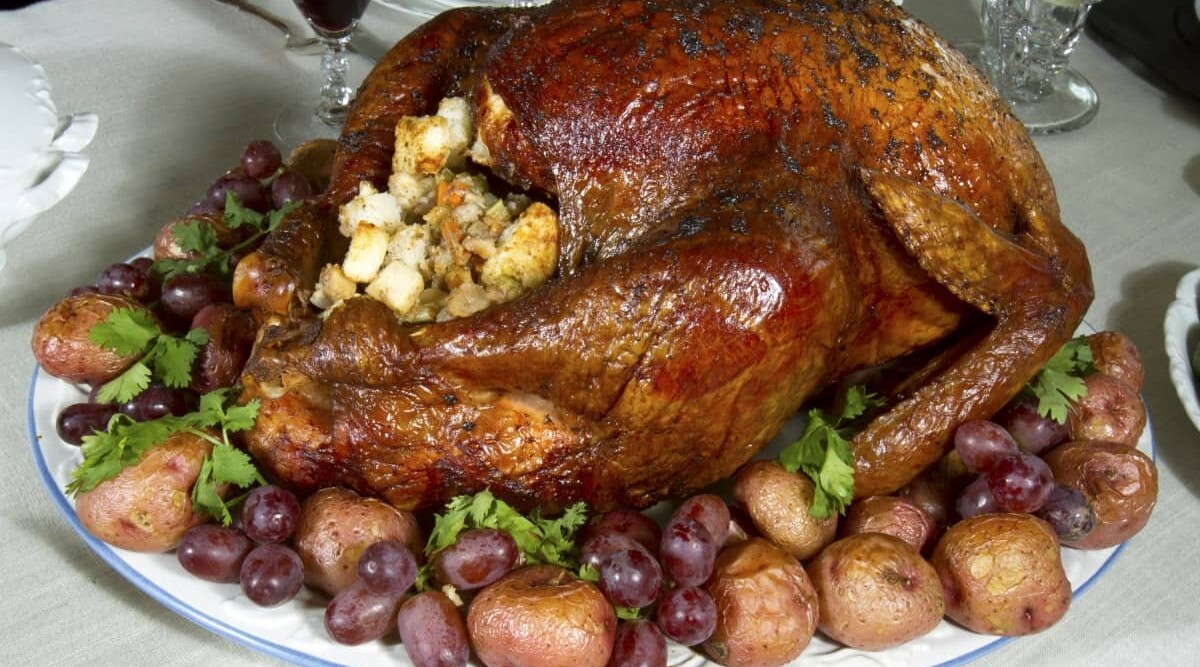
My favorite wood for smoking Turkey just has to be cherry. I love the red hue it gives to the skin, which makes the bird so visually appealing once cooked. In the absence of cherry, my second favorite would be apple. It’s mild enough to not overpower, while still giving a delicious hint of smoke.
But what do the BBQ community at large consider best? Read aon to discover the best woods for smoking turkey, what they bring to the table, and how they will help you to create the best smoked turkey possible.
It’s time for true confessions: I was a fully grown adult with kids before I ate smoked turkey for the first time. And it’s not because I didn’t like turkey. Turkey was the centerpiece of every Christmas dinner of my entire life, and turkey sandwiches and turkey soup lasted through January. I even squabbled good-naturedly with my grandmother over the neck.
But, they were always oven-roasted affairs. Later in life, my mom would cook the turkey on a gas grill to free up the oven for other things. No smoke.
My first smoked turkey experience was at Walt Disney World in Florida in the mid-2000s, when I finally tried the legendary Jumbo Turkey Leg. While I felt like an absolute savage, it was incredibly delicious.
If you’ve never had smoked turkey before, you don’t have to wait for a vacation or wear a funny hat with ears — you can do it yourself on your smoker or grill. (You can still opt for the hat if that’s how you roll.)
To help you max out on flavor, this article is all about choosing wood for smoking a delicious turkey. I’ll share which woods are generally accepted as the best for the bird and check in with the experts to see their advice for what they use in their smokers.
Shall we talk turkey?
Jump to:
- 1 Quick Reference Table: Best Woods for Smoking Turkey, With Flavor Notes
- 2 Which Woods do I Use to Smoke Turkey?
- 3 Why You Should Definitely Add Smoke to Your Turkey
- 4 Don’t Overpower Your Turkey With Too Powerful a Smoke Flavor
- 5 Preferred Smoking Woods for Turkey for a Mild, Complementary Flavor
- 6 Woods to Smoke Turkey With For Those Who Like a Strong Smoky Hit
- 7 You Can Mix Woods for Custom Flavor Profiles!
- 8 Best Wood for Smoking Turkey — What the Experts Use
- 9 Logs, Chunks, Chips, Pellets Or Dust?
- 10 Final Thoughts
Quick Reference Table: Best Woods for Smoking Turkey, With Flavor Notes
This concise table shows the most popular and most highly recommended smoking woods for turkey, with a brief description of the flavor profile each variety can be expected to add to the meal.
| Wood Type | Flavor Profile |
|---|---|
| Maple | Mild, slightly sweet, smooth |
| Cherry | Mild, sweet, fruity with color enhancement |
| Pecan | Mild, nutty, slightly sweet |
| Apple | Mild, sweet, fruity |
| Alder | Light, subtly sweet, delicate |
| Hickory | Strong, traditional smoky |
| Mesquite | Very strong, earthy, distinct sharpness |
| Oak | Medium, balanced smoky |
Which Woods do I Use to Smoke Turkey?
At risk of sounding like a broken record on repeat, I love cherry wood smoke for my turkey (as I do with chicken, and mixed with other woods for pork and briskets too!)
Cherry complements turkey well without overpowering it, and the visually pleasing red hue cherry smoke gives to the skin is simply amazing. We eat with our eyes, so start the meal by ogling a cherry smoke dressed turkey, before feasting on the elevated flavors from the mild and sweet smoke.
I have experimented with various other woods for smoking turkey, and out of of the other woods I tried apple gave me and my family the most favorable results (I always ask for their feedback!)
Why You Should Definitely Add Smoke to Your Turkey
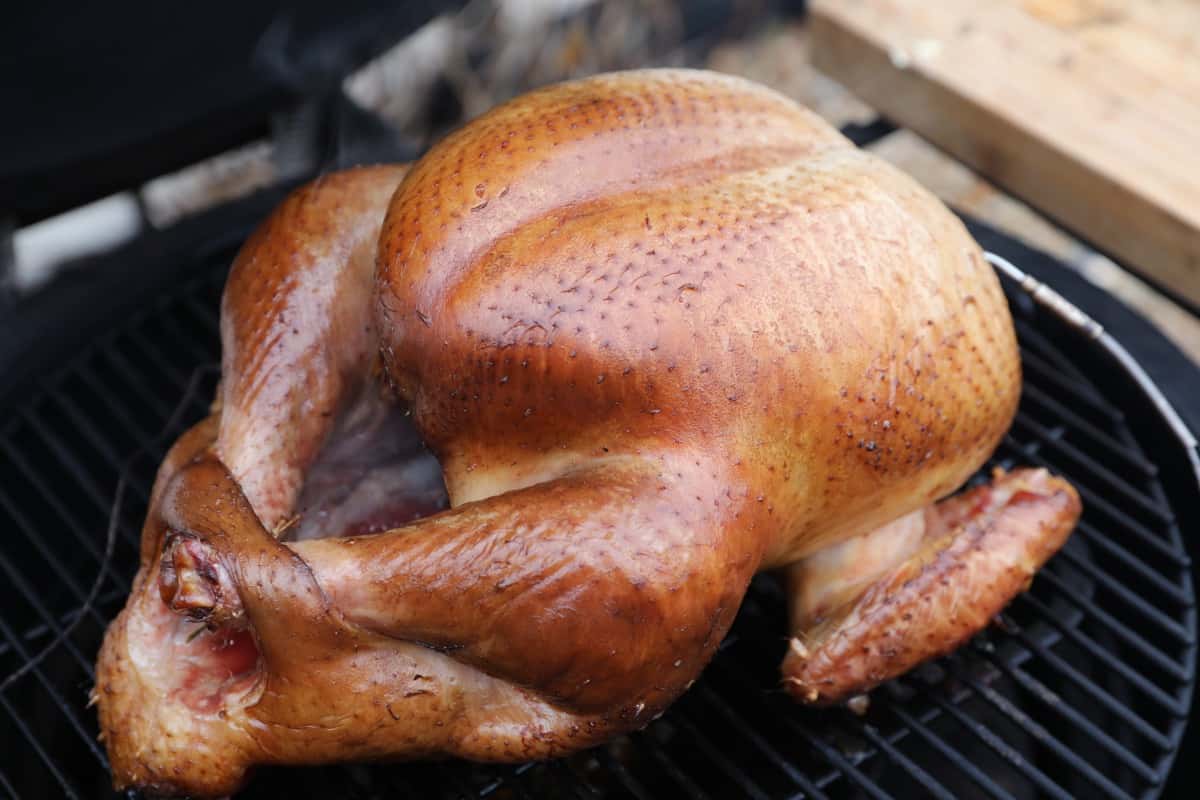
You could, like my mom, simply roast a turkey on a barbecue without adding any smoke. But then you’re missing out on the one incredible benefit of smoking.
Flavor.
Smoke from burning hardwood adds incredible flavor to food, transforming the ordinary into the extraordinary. Done right, smoke will complement and enhance the natural flavors of a turkey.
It also imparts a gorgeous color to the turkey skin, turning it anywhere from golden to mahogany. I like to say we eat with our eyes, and I know you’ve experienced it yourself — food that looks good tastes good.
Plus, as my mom knew, cooking the turkey outside leaves your oven available for casseroles, desserts, and more.
Don’t Overpower Your Turkey With Too Powerful a Smoke Flavor
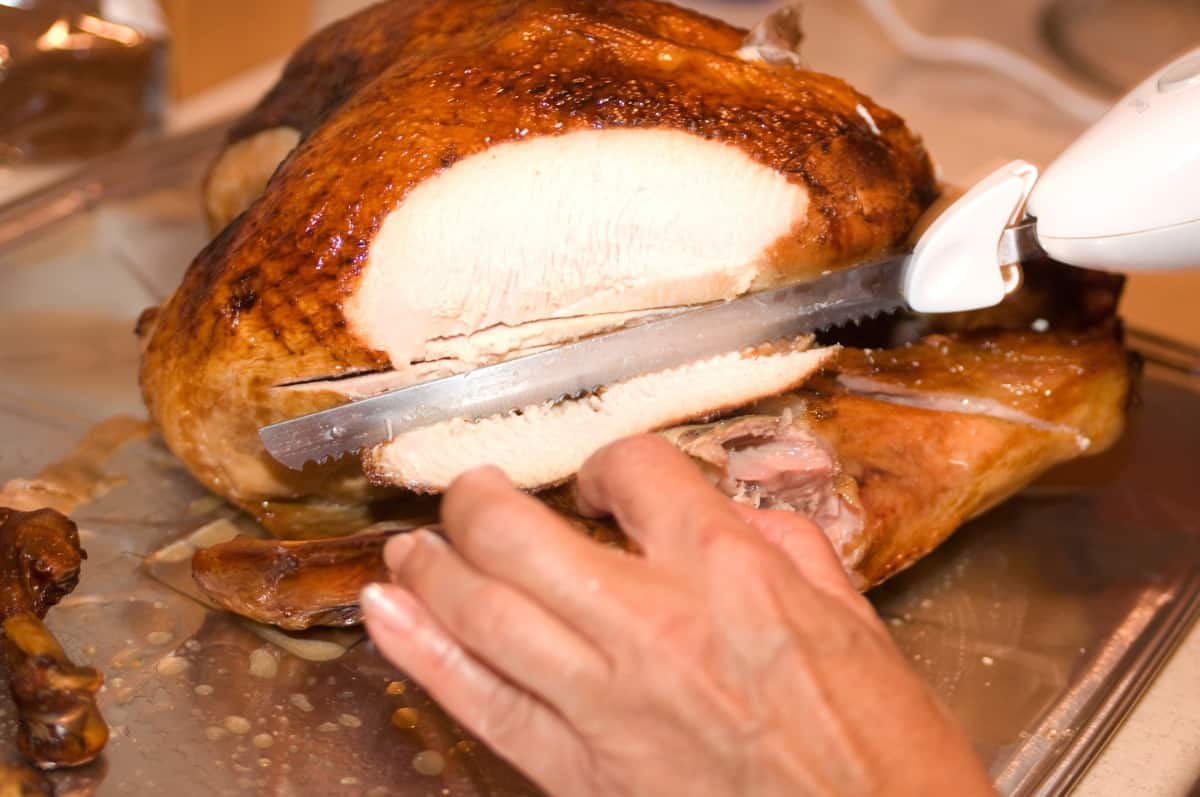
What’s sauce for the goose isn’t always sauce for the gander. Or, in our case, what’s smoke for the brisket isn’t (necessarily) smoke for the turkey.
Turkey is delicious but mild compared to beef. Therefore, the bold smokiness we might want on beef ribs can overwhelm a turkey.
It’s better to go with a lighter-tasting smoke. These are typically the fruit woods and nut woods, which will lend a lovely taste to your turkey, but still allow the inherent deliciousness to shine through.
Preferred Smoking Woods for Turkey for a Mild, Complementary Flavor
Here are our top choices for a magnificent smoked turkey, with enough smokiness to satisfy but leaving plenty of room for sauces, spices, and natural turkey flavor.
Maple
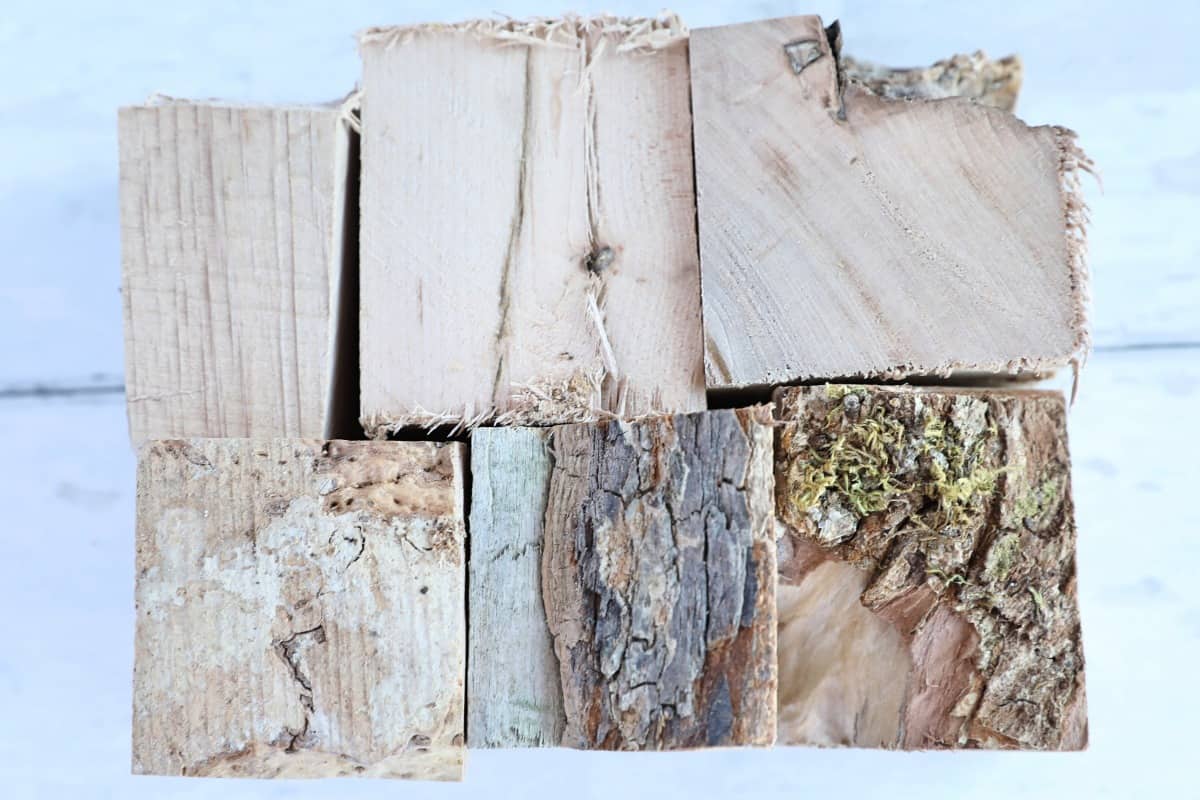
Maple is a can’t-miss wood for turkey to add a light touch with a bit of sweetness, .
The flavor has broad appeal, even for those who aren’t into smoke. Plus, you get a lovely dark gold color after a long smoke over maple.
Cherry
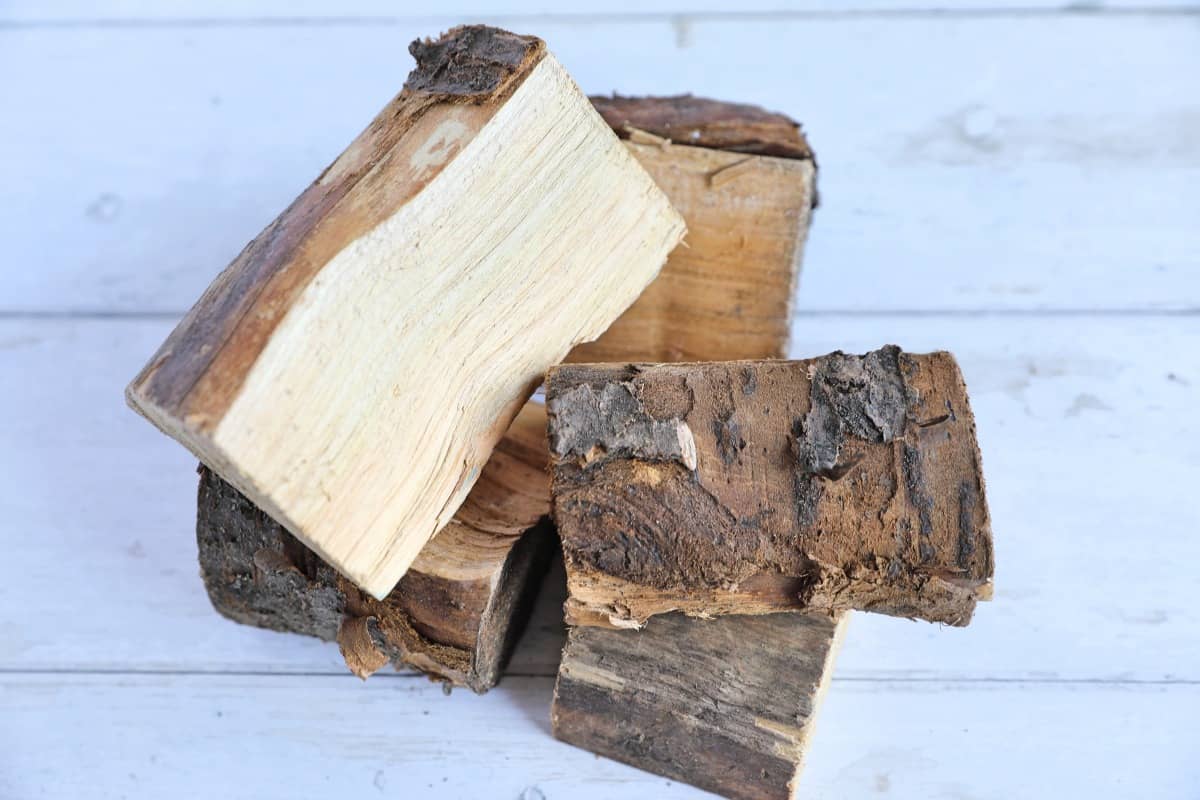
It’s tough to beat cherry for its one-two punch of color and flavor. You’ll enjoy not only a hint of sweetness with the smoke, but also a deep, rich hue on the skin.
A turkey smoked over cherry wood is one you take a picture of and post on your Facebook feed.
Pecan
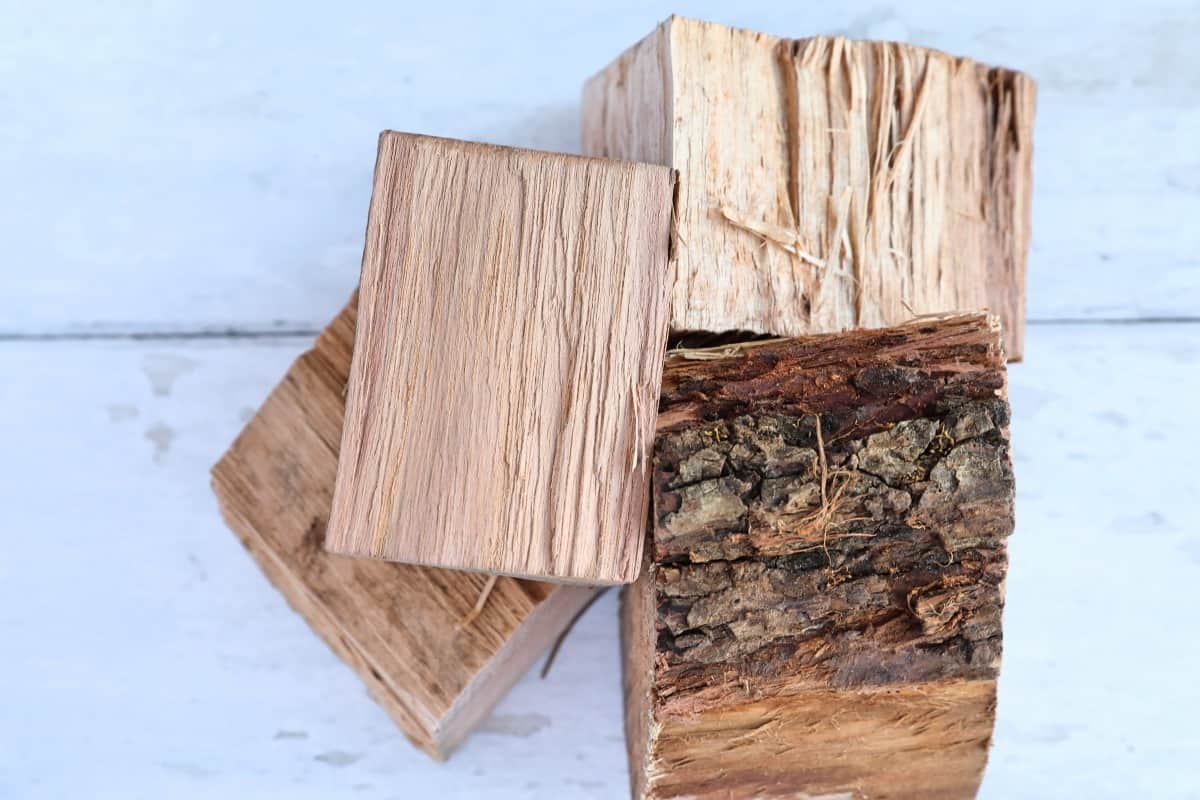
Here’s one you’ll go nuts for. Pecan wood is sweet, but adds a hit of nuttiness to your turkey.
Go easy at first; pecan can be too sweet for some palates.
Apple
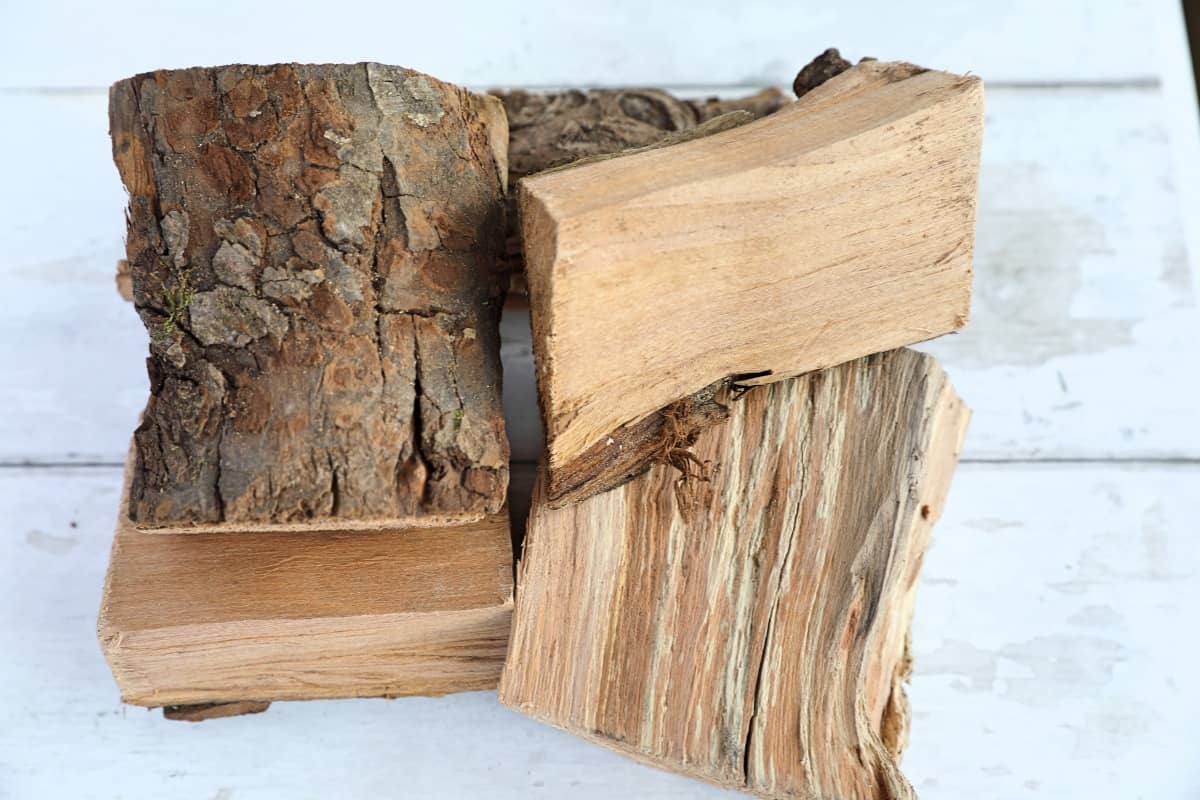
Apple is a classic smoking wood for turkey. Sweet and fruity, but much more subtle than cherry or pecan. It’s very mild, so you’ll want to give apple smoke a long time to permeate your turkey. Keep a close eye on your bird to be sure it doesn’t dry out.
By the way, if you think I’m stuck on sweet woods for turkey, you’re right. It just works with the mild but succulent taste of poultry. And, think about what you’re serving turkey with — cranberry sauce, sweet potatoes (maybe with marshmallows), roasted apples, and so on.
Never forget the bigger picture of your entire meal, and strive for a harmonious blend of flavors.
Alder
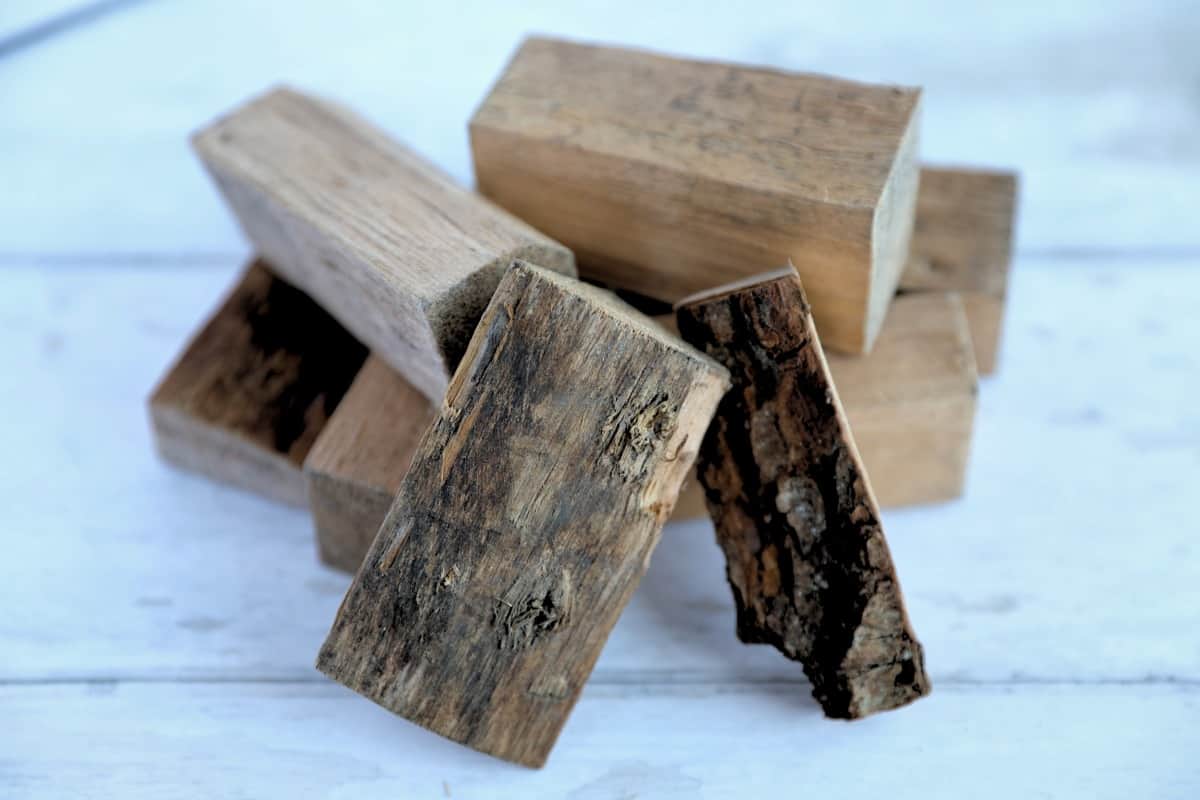
Give alder a try for a break from all the sweetness. It’s mild and earthy, and it’s tough to overdo it. It’s another good choice when you need to please a crowd.
Newbies to smoking like it, too, for being so forgiving.
Woods to Smoke Turkey With For Those Who Like a Strong Smoky Hit
Although keeping your smoke mild is the best overall choice for turkey, some folks (myself included) just can’t get enough smoke.
So here are a couple of smoking wood options to consider for a bigger smoky punch in your poultry.
Mesquite
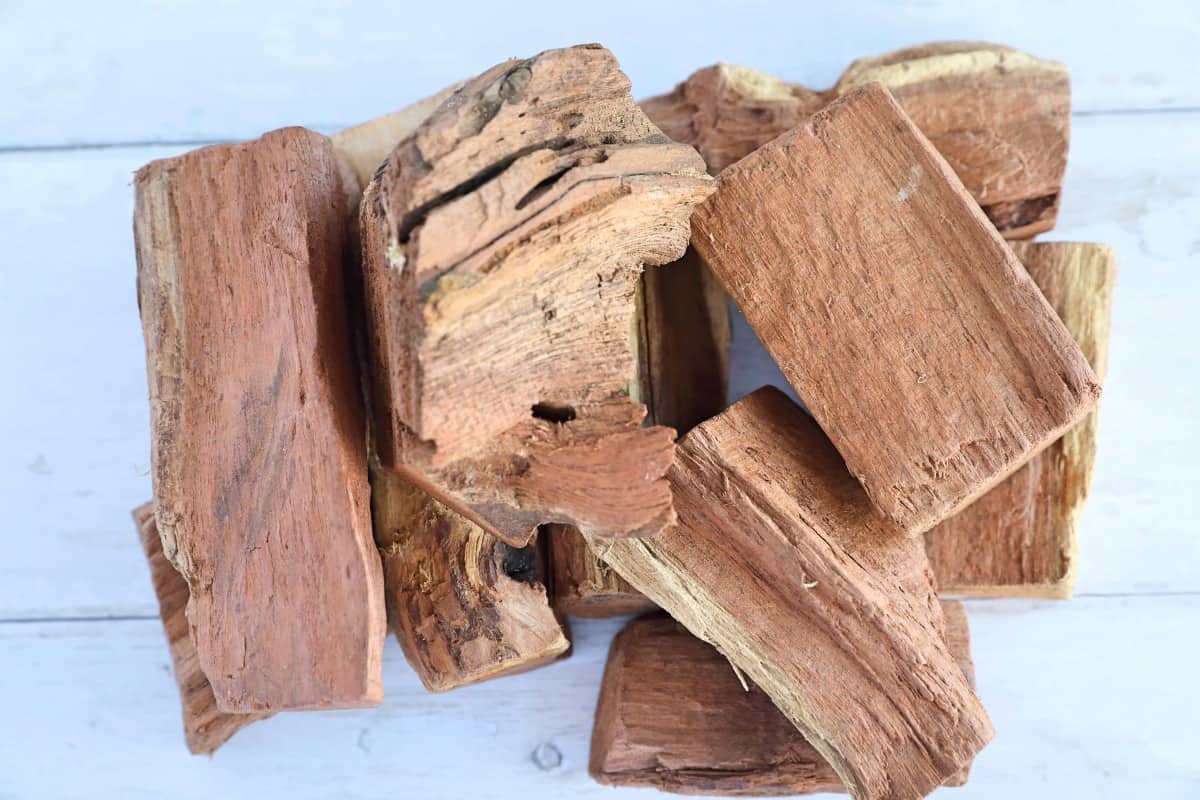
Mesquite is an intensely smoky wood, and for some people, it’s too much. Still, it adds nice color and rich smoky flavor, so you might enjoy it infused into a big ol’ bird like a turkey.
Go easy on this one, though; too much mesquite is bitter and unpleasant. Not recommended for smoking rookies.
Oak
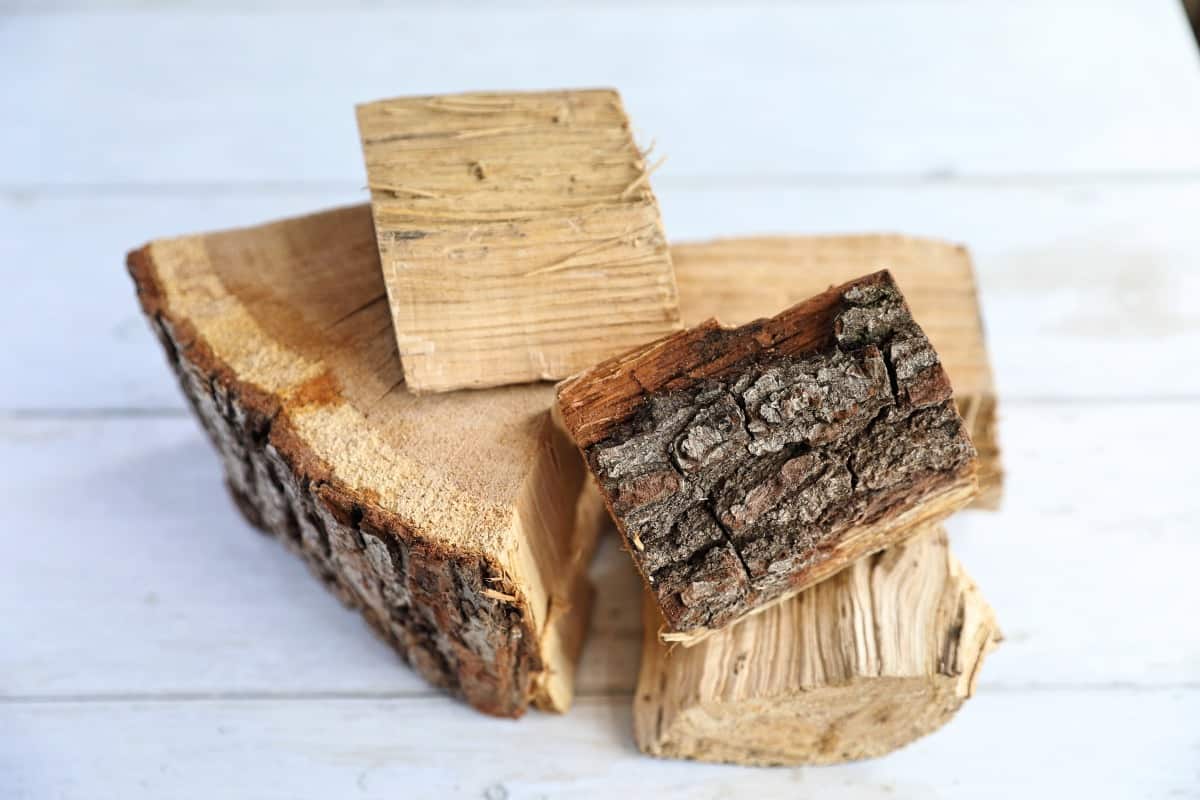
Oak is a strong but generic wood for smoking. It’s an excellent choice for turkey to add smoke that complements savory sauces and seasonings, or blending with fruit woods to temper the sweetness.
I really like a mix of oak and cherry, for a medium strength smoky taste from the oak, along with the color added by the cherry smoke.
You Can Mix Woods for Custom Flavor Profiles!
As I suggested in the “Oak” section, you can mix woods to create your own blends.
One of the most common ways to do this is to use half strongly flavored wood and half fruit wood. Combining woods allows you to balance qualities and keep one particular flavor from overwhelming your turkey.
Try experimenting with mixes of your favorite woods to discover what works best for you.
Best Wood for Smoking Turkey — What the Experts Use
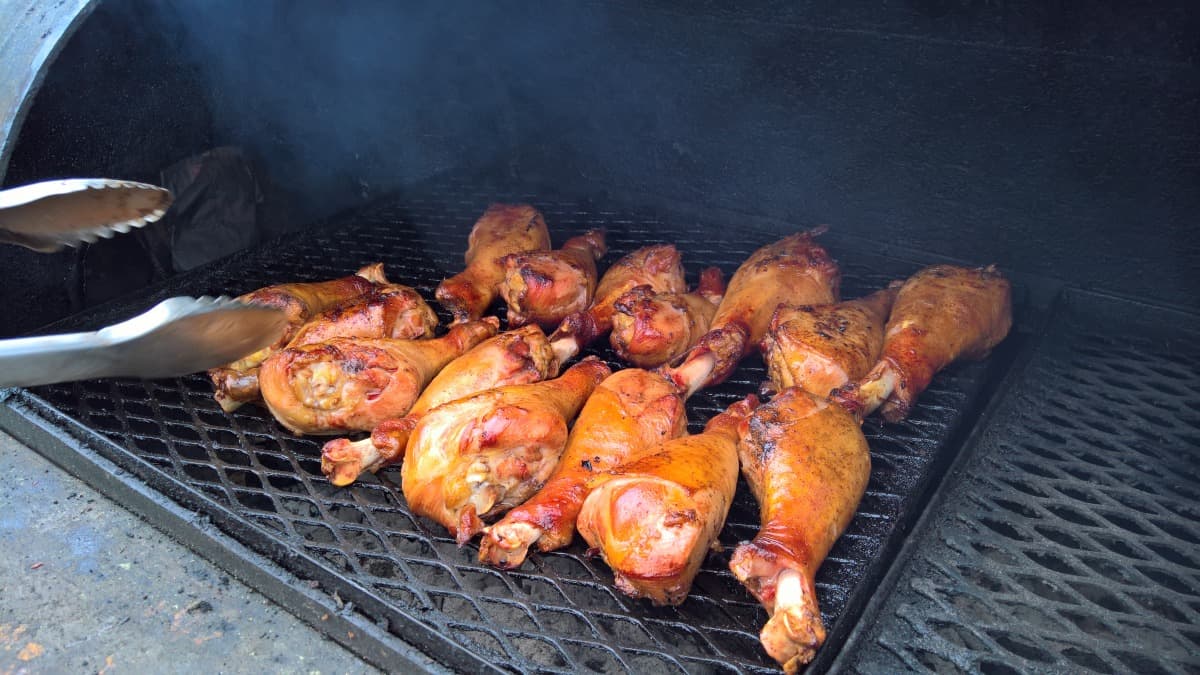
It’s never a bad idea to check in with the pros and see what they recommend. You can learn from their years of experience and experimentation and skip right to the good stuff without wasting your own time, money, and food.
Meathead Goldwyn
The man who loves to challenge barbecue conventions has pretty traditional leanings when it comes to smoking turkey.
Apple chunks are his go-to, but he cautions us to go easy on it, lest we risk over-smoking the bird. The sweet taste of apple pairs well with the classic woody, savory seasonings thyme and sage he favors for seasoning both the turkey and the gravy.
Jess Pryles
Although she’s better known for her beef and ribs, Jess is no stranger to turkeys.
For her smoked turkey breast, she lists peach wood as her number one pick for her smoked turkey breast, citing the delicate sweetness as the right fit.
Susie Bulloch
The founder of HeyGrillHey lists hickory as one of her favorites for smoking turkey, a divisive wood that lands on just as many “avoid” lists as it does “recommended” lists.
Since she also recommends an apple brine and/or a sweet rub, the classic American taste and distinctly powerful smack of smokiness should complement those add-on flavors nicely.
Malcom Reed
For delicious smoked turkey in a Traeger, Malcom picks his pellets based on the recipe.
While he runs with apple for his BBQ Smoked Turkey for some sweetness to go with the white BBQ sauce, he chooses pecan for some nutty notes in his Honey Smoked Turkey Breast.
Check out his many turkey recipes — it’s a good lesson in matching flavor woods to specific recipes.
Steven Raichlen
For his Project Smoke rendition of a smoked turkey, the creator of Barbecue Bible selected maple.
This seems like a great choice for the Double Whiskey-Smoked Turkey recipe and the accompanying meal; he smoked everything, so mild maple makes sense since it’s hard to have too much.
Logs, Chunks, Chips, Pellets Or Dust?
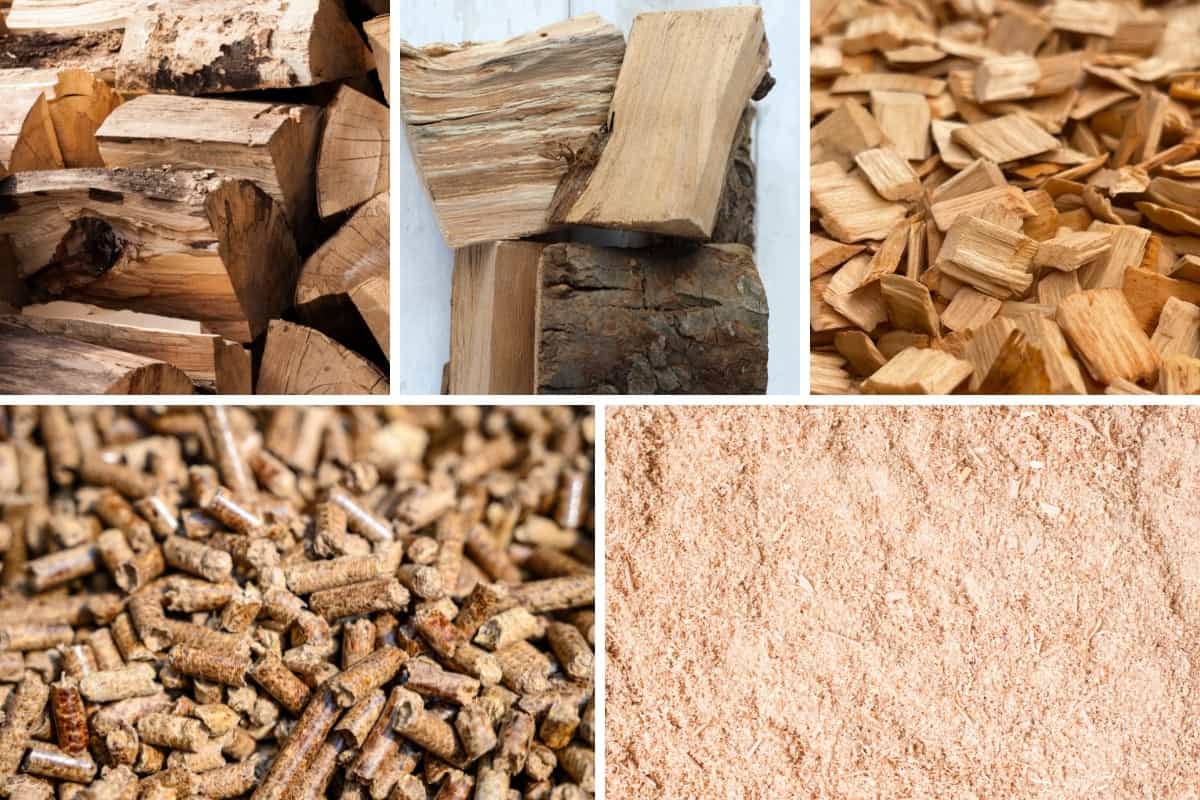
What’s the right style of wood to use when you smoke a turkey? Well, that depends on what you’re smoking it in. Here’s a rundown of every type of smoking wood and when to use each one.
Logs
Use these full-size pieces of wood in your large offset smoker, where there’s plenty of room and plenty of distance from your food.
Chunks
Chunk wood is meant to distribute over top of lit charcoal. Use this in your smaller offset smoker, barrel or bullet smoker, kamado or ceramic cooker.
I’ve seen some people suggest placing wood chunks right on the heat deflectors or flavorizer bars on your gas grill set up for indirect cooking. I haven’t tried it, and I’m not sure if I would, especially since I recently bought a new grill. Maybe in a few years, when the warranty expires, I’ll give it a shot.
Chips
These small bits of wood smolder and burn easily thanks to their slim profile. (Which means I must be virtually fire-proof.) Chips are commonly used in gas and electric smokers, but you can also sprinkle them on charcoal or use them on a gas grill with a foil packet or smoker box.
Pellets
Machine-made pellets are comprised of sawdust and binding agents and are meant for use in dedicated pellet smokers. They’re also great in smoker boxes for use on gas grills.
Sawdust
This fine powder combusts easily and is often used in electric smokers and handheld smokers, sometimes called smoke guns.
Final Thoughts
As with everything barbecue, there’s lots of leeway for personal expression and experimentation. Only you can decide what tastes best, but it helps to start with some basic guidelines.
I’d say start simple with one of our recommended woods and, over time, try mixing it up with more or less smoke and combos of two kinds of wood or more. With experimentation you will soon discover what the best wood for smoking turkey is to please your own tastes.
Got a favorite wood or blend for turkey that we missed? Let us know! Leave a comment below, we’re always happy to learn from our readers.
Thanks for hanging out, and good luck with your next turkey.


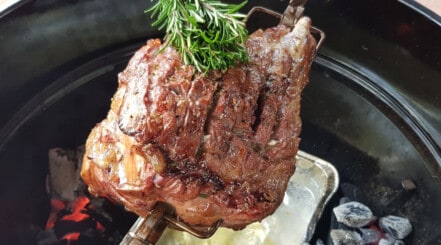
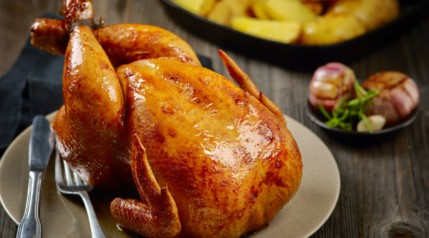
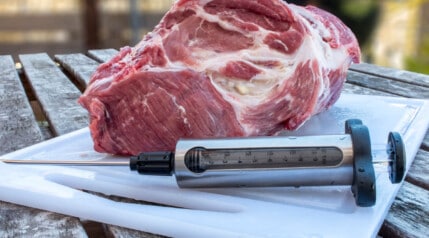

Hi, I’m looking to smoke a Turkey using pellets. I want to do a mix of Oak and Pecan, should I go 50/50 or 60/40 Pecan and Oak? Thanks
I’d go 60/40 with more pecan than oak, or maybe even 70/230! This is because pecan can quite easily be ‘drowned out’ by the stronger flavored oak.